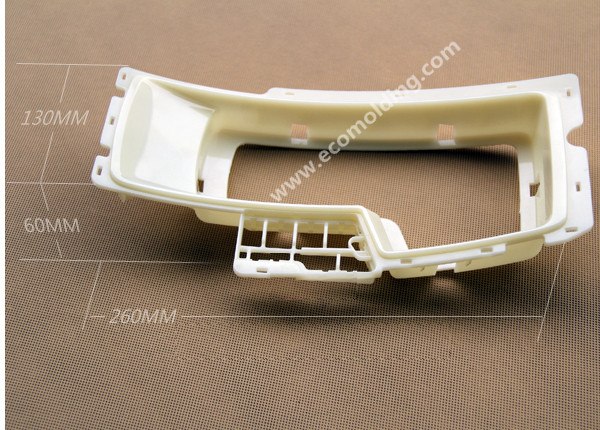ABS Plastic Resin Introduction
ABS(Acrylonitrile Butadiene Styrene ) is one of the five major synthetic resins, which is excellent in resistance to impact, heat, low temperature and chemicals, in addition to outstanding electrical properties. It is very easy to process and stable in product size, with a high level of surface glossiness. It is also easy to paint and color. Besides, it can be used for secondary processing, such as surface metallization, electroplating, welding, hot pressing and bonding. As a versatile engineering thermoplastic, it is widely used in such industrial fields as machinery, automobile, electronic appliances, instruments, textile and construction, etc.

ABS resin is currently the most widely used polymer with the highest production. It organically combines the properties of PS, SAN and BS, and boasts excellent mechanical properties of toughness, hardness and rigidness. ABS is a terpolymer of acrylonitrile, butadiene and styrene. A refers to acrylonitrile, B refers to butadiene, and S refers to styrene. Its chemical name is thus Acrylonitrile Butadiene Styrene.
ABS Plastic Resin properties
General Properties: ABS is opaque and ivory-colored pellets, but its products can be colorful with a high level of surface glossiness. The relative density of ABS is about 1.05, and the water absorption rate is quite low. ABS combines well with other materials and is easy to surface print, coat and plate. As a flammable polymer, ABS has an oxygen index of 18 to 20, of which the flame is yellow with black smoke and a special odor.
ABS (Acrylonitrile Butadiene Styrene)
The resin is a general term for a group of impact-resistant thermoplastic resins composed of the three components, acrylonitrile, butadiene, and styrene.

ABS Components
ABS is a two-phase heterogeneous polymer of a resin phase (AS) and a rubber phase (PS).
The properties of the resin is affected by the composition of the resin phase, the composition / proportion of the rubber phase, the compatibility of the rubber-resin interface, and the grafting ratio.
Influence of Each Component on the Properties
The AS component:
Improve surface glossiness, resistance to heat / chemicals, and processability, but reduce impact toughness.
The PB component:
Improve elasticity and resistance to impact, but with insufficient resistance to heat and rigidity.
ABS resin combines the strengths of two components.
Mechanical Properties: ABS possesses excellent mechanical properties / impact strength, and can be used under extremely low temperature conditions; ABS boasts excellent resistance to wear, great dimensional stability, and can be applied to bearings working under medium load and speed conditions. The creep resistance of ABS is higher than that of PSF and PC, but lower than that of PA and POM. The bending and compressive strength of ABS is weaker when compared with other plastics. nThe mechanical properties of ABS are greatly influenced by temperature.
Thermal Properties: The heat distortion temperature of ABS ranges from 93 to 118°C, and that of the product can be improved by about 10°C after annealing. ABS can still demonstrate a certain degree of toughness at -40°C, so it can be applied in the temperature range between -40 to 100°C.
Electrical Properties: ABS exhibits great electrical insulation and is hardly affected by temperature, humidity and frequency, so it is able to be used in most environments.
Environmental Properties: ABS is not affected by water, inorganic salts, alkalis and various acids, but is soluble in ketones, aldehydes and chlorinated hydrocarbons. It is subject to stress cracking due to erosion by glacial acetic acid and vegetable oil. ABS has poor weatherability and is prone to degradation under the effect of UV light; after being placed outdoors for half a year, its impact strength will be reduced by half.
Injection Molding Processability of the ABS Plastic Resin: Like PS, ABS is a thermoplastic with excellent processability and is able to be processed by general processing methods. The melt flowability of ABS is similar to that POM, which is better than that of PVC and PC, but worse than that of PE, PA and PS. The melt viscosity of ABS is dependent on injection molding processing temperature and shear rate, but it is more sensitive to the latter. ABS possesses great thermal stability and is not prone to degradation.
ABS plastic features a high water absorption rate, so it needs to be dried before injection molding processing. Usually, the general product should be dried under 80-85°C temperature conditions for 2-4 hours; products with special requirements (such as electroplating) need to be dried under 70-80°C temperature conditions for up to 18 hours. ABS products are prone to internal stress during processing, which can be tested by immersion in glacial acetic acid. If the stress is too high while stress cracking is not allowed, the product should then be annealed – put it in a 70-80℃ hot air drying oven for 2-4 hours, then cool it to room temperature.
Applications of the ABS plastic resin
1. Housing Material
Widely used in the production of housings for telephones, mobile phones, copiers, fax machines, toys and kitchenware.
2. Auto Parts

The specific items include steering wheel, instrument panel, fan blades, fenders, handles and armrests.
3. Machinery Parts
ABS can be used to produce gears, pump impellers, bearings, handles, tubing, fittings, battery compartments and power tool housings.
Please feel free to contact us if you are looking for professional plastic mold making company.
